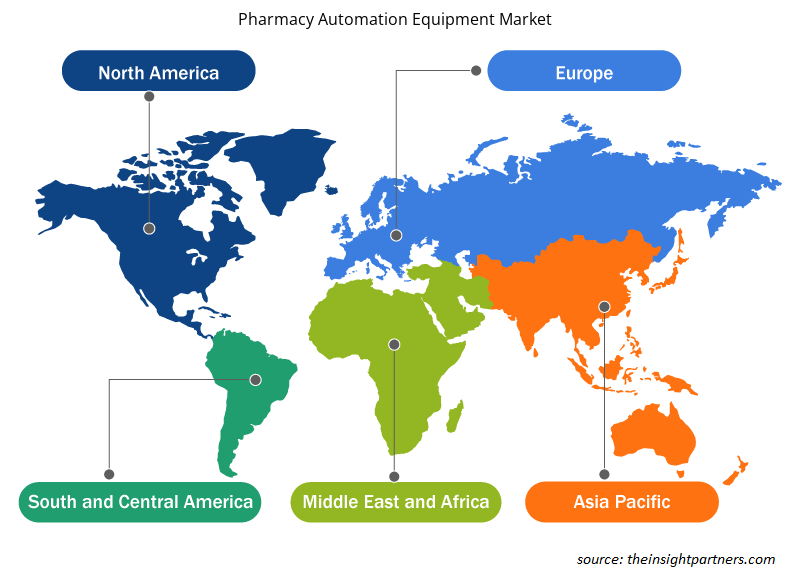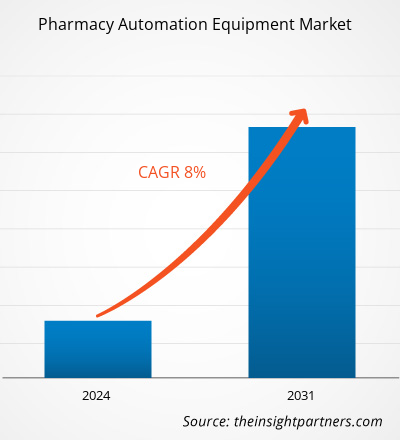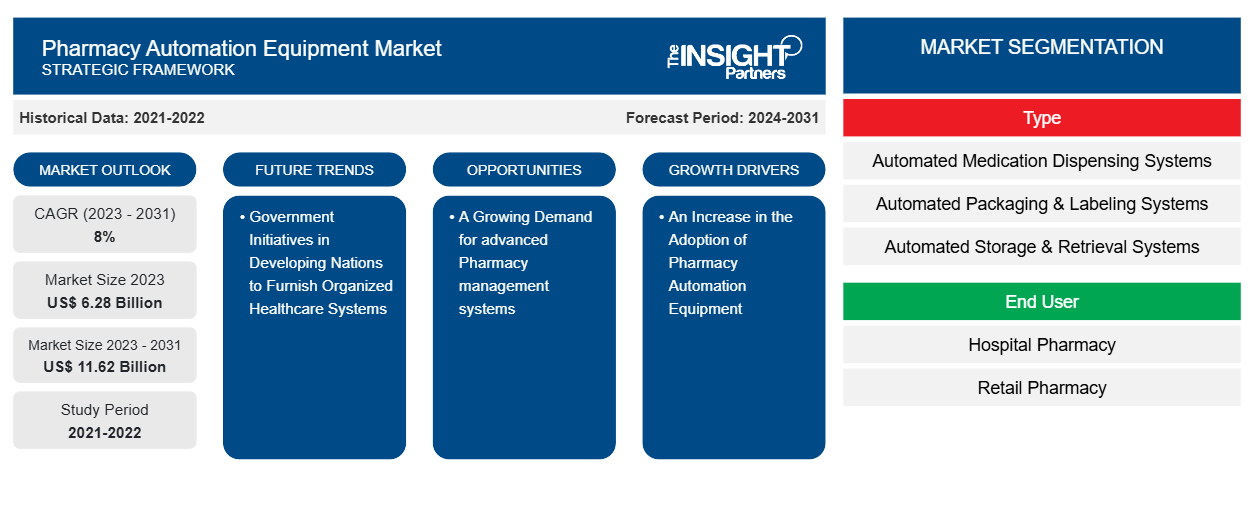من المتوقع أن يصل حجم سوق معدات أتمتة الصيدلة إلى 11.62 مليار دولار أمريكي بحلول عام 2031 من 6.28 مليار دولار أمريكي في عام 2023. ومن المتوقع أن يسجل السوق معدل نمو سنوي مركب بنسبة 8.00٪ خلال الفترة 2023-2031. ومن المرجح أن يظل ظهور أنظمة صرف الأدوية والروبوتات والذكاء الاصطناعي والصيدليات عن بعد وأنظمة إدارة المخزون الآلية اتجاهًا رئيسيًا في السوق.
تحليل سوق معدات أتمتة الصيدلة
بفضل التقنيات الجديدة، يتغير قطاع الرعاية الصحية باستمرار ويتحسن، وخاصة بالنسبة للصيدليات. وللحفاظ على الوقت والدقة، تحتاج الصيدليات إلى استخدام مجموعة متنوعة من الأنظمة، لذلك يجب على العاملين في هذا المجال مواكبة التطورات التكنولوجية. كانت أتمتة الصيدليات رائدة في الثورة التكنولوجية لتحسين حياة المرضى ومقدمي الرعاية الصحية. يمكن للصيادلة الآن التعامل مع وصفات المرضى بكفاءة أكبر والعمل بشكل أكثر إنتاجية بسبب الأتمتة، والتي يمكنها التعامل مع أي شيء من الأعمال الشاقة إلى التبادل السلس للمعلومات الصحية.
نظرة عامة على سوق معدات أتمتة الصيدلة
إن سوق أنظمة أتمتة الصيدلة مدفوع بالمزايا العديدة التي تقدمها للصيدليات. تعمل الأتمتة على تعزيز الدقة وسير العمل في الصيدلية وتجربة المريض مع خفض النفقات والأخطاء المتعلقة بالأدوية. تشير التوقعات المستقبلية لسوق الأتمتة العالمية إلى نمو هائل في الطلب على الوصفات الطبية والمعدات التقنية وتوسيع المعرفة التكنولوجية. ينمو مجال الرعاية الصحية الرقمية بسرعة ويهيمن. سيزداد عدد الوصفات الطبية المكتوبة جنبًا إلى جنب مع شيخوخة السكان، مما يعني أن الأتمتة سيكون لها تأثير كبير على ممارسة الصيدلة في المستقبل. تجمع الأتمتة حاليًا بين وضع العلامات والتعبئة والتخزين والتوزيع الآلي لتقليل الأخطاء في التوزيع وتعزيز الإنتاجية لقادة الصيدلة. من هذه النقطة فصاعدًا، ستستخدم الشركة الإلكترونيات والتكنولوجيا فقط للنمو.
قم بتخصيص هذا التقرير ليناسب متطلباتك
ستحصل على تخصيص لأي تقرير - مجانًا - بما في ذلك أجزاء من هذا التقرير، أو تحليل على مستوى الدولة، وحزمة بيانات Excel، بالإضافة إلى الاستفادة من العروض والخصومات الرائعة للشركات الناشئة والجامعات
-
احصل على أهم اتجاهات السوق الرئيسية لهذا التقرير.ستتضمن هذه العينة المجانية تحليلاً للبيانات، بدءًا من اتجاهات السوق وحتى التقديرات والتوقعات.
محركات وفرص سوق معدات أتمتة الصيدلة
زيادة استخدام معدات أتمتة الصيدلة تعزز نمو السوق
يتم الآن أتمتة الصيدلة باستخدام الروبوتات والذكاء الاصطناعي. يمكن للأجهزة الميكانيكية المعروفة باسم روبوتات الصيدلة تكرار السلوك البشري بمجرد برمجتها للقيام بذلك دون مساعدة المشغل المستمرة. على سبيل المثال، يتم تصنيف الكثير من أنظمة سير العمل الآلية، وأنظمة الترميز الشريطي للصيدلة، وأنظمة صرف الأدوية على أنها روبوتية. الذكاء الاصطناعي (AI) هو مجال سريع التطور في تكنولوجيا الصيدلة يمكن تطبيقه على مهام مختلفة مثل علم الأدوية المتعددة، وتصميم أشكال الجرعات، واكتشاف الأدوية، وبرامج الكمبيوتر، وصيدلة المستشفيات. نظرًا لأن الذكاء الاصطناعي يستخدم عادةً لمحاكاة المهام المعرفية البشرية، فقد تشهد صناعة الأدوية زيادة كبيرة في استخدامها لهذه التكنولوجيا. يمكن استخدامه للقيام بمهام تشبه الإنسان على أجهزة الكمبيوتر الرقمية أو الروبوتات التي يتم التحكم فيها بواسطة الكمبيوتر (مثل خزائن التوزيع الآلية). بدأت شركات الأدوية الرائدة في استخدام الذكاء الاصطناعي (AI) في البحث والتطوير، واكتشاف الأدوية، وتحليل نظام الرعاية الصحية، ودقة الأدوية، والدعم الطبي، والمساعدة، والمساعدة في المهام المتكررة، وتصميم خطة العلاج، وصيانة السجلات الصحية. يمكن استخدام الذكاء الاصطناعي في صيدليات المستشفيات لأغراض متنوعة، بما في ذلك مسح الباركود، وإعداد الأدوية آليًا، والتتبع الآلي، والتوزيع. وبالتالي، من المرجح أن يؤدي زيادة الاستخدام إلى جانب التطبيقات الناشئة لأنظمة أتمتة الصيدلة إلى دفع نمو السوق.
المبادرات الحكومية في الدول النامية
ولأن تكاليف الرعاية الصحية آخذة في الارتفاع وهناك ضغوط متزايدة لتحسين الوصول إلى الخدمات، فإن إدارة الأدوية تلعب دوراً حاسماً في البلدان النامية. على سبيل المثال، توسع دور الصيدلي ليشمل ضمان المشورة المناسبة والمراقبة والالتزام بالأدوية، فضلاً عن منع تطور مقاومة أدوية فيروس نقص المناعة البشرية في العديد من البيئات المحدودة الموارد المثقلة بالفيروس. وهذا يولد الحاجة إلى حلول تكنولوجية متطورة. وتنفذ حكومات الدول النامية العديد من التدابير لتسهيل الحصول على هذه الأدوية. على سبيل المثال، لتحسين تقديم علاج فيروس نقص المناعة البشرية، نفذت وزارة الصحة والخدمات الاجتماعية في ناميبيا صرف الأدوية لعدة أشهر لتمكين توسيع نطاق العلاج المضاد للفيروسات القهقرية. وفي مرافق الرعاية الصحية في ناميبيا، يتم استخدام هذا على نطاق واسع حالياً، مما يساعد في تحقيق أهداف علاج فيروس نقص المناعة البشرية في البلاد. في الهند، يشكل قطاع المستشفيات 80٪ من سوق الرعاية الصحية بالكامل. وهناك طلب كبير عليه من المستثمرين المحليين والدوليين. وبالتالي، خلال الفترة المتوقعة، من المحتمل أن تولد هذه العوامل فرص نمو كبيرة لسوق معدات أتمتة الصيدلة.
تقرير تحليل تجزئة سوق معدات أتمتة الصيدلة
إن القطاعات الرئيسية التي ساهمت في اشتقاق تحليل سوق معدات أتمتة الصيدلة هي النوع والمستخدم النهائي.
- بناءً على النوع، ينقسم سوق معدات أتمتة الصيدلة إلى أنظمة صرف الأدوية الآلية، وأنظمة التعبئة والتغليف والتصنيف الآلية، وأنظمة التخزين والاسترجاع الآلية، وأجهزة التركيب الآلية، وعدادات الأقراص على سطح الطاولة. احتل قطاع أنظمة صرف الأدوية الآلية الحصة السوقية الأكبر في عام 2023.
- بحسب المستخدم النهائي، يتم تقسيم السوق إلى صيدليات المستشفيات وصيدليات التجزئة وغيرها. احتل قطاع صيدليات المستشفيات الحصة الأكبر من السوق في عام 2023.
تحليل حصة سوق معدات أتمتة الصيدلة حسب المنطقة الجغرافية
ينقسم النطاق الجغرافي لتقرير سوق معدات أتمتة الصيدلة بشكل أساسي إلى خمس مناطق: أمريكا الشمالية، وآسيا والمحيط الهادئ، وأوروبا، والشرق الأوسط وأفريقيا، وأمريكا الجنوبية والوسطى.
استحوذت أمريكا الشمالية على أكبر حصة من السوق العالمية، حيث كان النمو مدفوعًا بعوامل مثل التبني المتزايد لمعدات أتمتة الصيدلة في الولايات المتحدة، والوعي المتزايد بالصحة العامة، والمبادرات الحكومية المتزايدة، ووجود اللاعبين الرائدين. يعد زيادة أخطاء الأدوية والطلب المتزايد على المنتجات الصيدلانية أحد المحركات الرئيسية لنمو السوق. يشير عدد المرضى المتزايد في الولايات المتحدة إلى زيادة في عدد المرضى الذين يتناولون أدوية متعددة يوميًا. تظهر الأبحاث أنه في الولايات المتحدة، أكثر من 50٪ من المرضى لديهم وصفة طبية واحدة على الأقل، ويتناول العديد منهم أدوية متعددة يوميًا، مما يعرضهم لخطر متزايد من أخطاء الأدوية والمخاطر الصحية المحتملة. من المتوقع أن يكون الطلب المتزايد على المنتجات الصيدلانية، والتكنولوجيا المتقدمة، والحاجة إلى معدات وأدوات روبوتية دقيقة لأداء المهام بكفاءة عوامل رئيسية لنمو السوق.
رؤى إقليمية حول سوق معدات أتمتة الصيدلة
لقد قام المحللون في Insight Partners بشرح الاتجاهات والعوامل الإقليمية المؤثرة على سوق معدات أتمتة الصيدلة طوال فترة التوقعات بشكل شامل. يناقش هذا القسم أيضًا قطاعات سوق معدات أتمتة الصيدلة والجغرافيا في جميع أنحاء أمريكا الشمالية وأوروبا ومنطقة آسيا والمحيط الهادئ والشرق الأوسط وأفريقيا وأمريكا الجنوبية والوسطى.

- احصل على البيانات الإقليمية المحددة لسوق معدات أتمتة الصيدلة
نطاق تقرير سوق معدات أتمتة الصيدلة
| سمة التقرير | تفاصيل |
|---|---|
| حجم السوق في عام 2023 | 6.28 مليار دولار أمريكي |
| حجم السوق بحلول عام 2031 | 11.62 مليار دولار أمريكي |
| معدل النمو السنوي المركب العالمي (2023 - 2031) | 8% |
| البيانات التاريخية | 2021-2022 |
| فترة التنبؤ | 2024-2031 |
| القطاعات المغطاة |
حسب النوع
|
| المناطق والدول المغطاة |
أمريكا الشمالية
|
| قادة السوق وملفات تعريف الشركات الرئيسية |
|
كثافة اللاعبين في سوق معدات أتمتة الصيدلة: فهم تأثيرها على ديناميكيات الأعمال
يشهد سوق معدات أتمتة الصيدلة نموًا سريعًا، مدفوعًا بالطلب المتزايد من المستخدم النهائي بسبب عوامل مثل تفضيلات المستهلكين المتطورة والتقدم التكنولوجي والوعي الأكبر بفوائد المنتج. ومع ارتفاع الطلب، تعمل الشركات على توسيع عروضها والابتكار لتلبية احتياجات المستهلكين والاستفادة من الاتجاهات الناشئة، مما يؤدي إلى زيادة نمو السوق.
تشير كثافة اللاعبين في السوق إلى توزيع الشركات أو المؤسسات العاملة في سوق أو صناعة معينة. وهي تشير إلى عدد المنافسين (اللاعبين في السوق) الموجودين في مساحة سوق معينة نسبة إلى حجمها أو قيمتها السوقية الإجمالية.
الشركات الرئيسية العاملة في سوق معدات أتمتة الصيدلة هي:
- شركة سيرنر
- أمريسورس بيرغن
- شركة باكستر الدولية
- تاليست ذ.م.م (سويس لوج هيلث كير)
- كابسا للرعاية الصحية
- بنغلاديش
إخلاء المسؤولية : الشركات المذكورة أعلاه ليست مرتبة بأي ترتيب معين.

- احصل على نظرة عامة على أهم اللاعبين الرئيسيين في سوق معدات أتمتة الصيدلة
أخبار سوق معدات أتمتة الصيدلة والتطورات الأخيرة
يتم تقييم سوق معدات أتمتة الصيدلة من خلال جمع البيانات النوعية والكمية بعد البحث الأولي والثانوي، والتي تتضمن منشورات الشركات المهمة وبيانات الجمعيات وقواعد البيانات. فيما يلي بعض التطورات في سوق معدات أتمتة الصيدلة:
- أعلنت شركة BD (Becton, Dickinson, and Company)، الشركة العالمية الرائدة في مجال التكنولوجيا الطبية، وشركة Frazier Healthcare Partners، وهي شركة استثمار خاصة رائدة تركز حصريًا على قطاع الرعاية الصحية، عن اتفاقية نهائية لشركة BD للاستحواذ على شركة Parata Systems، وهي شركة مبتكرة لحلول أتمتة الصيدليات، مقابل 1.525 مليار دولار. (المصدر: BD، بيان صحفي، يونيو 2022)
- الآن أصبح بإمكان الصيدليات الكندية التي تخدم المستشفيات والتجزئة وأسواق الرعاية طويلة الأجل الوصول إلى تكنولوجيا أتمتة الصيدلة من الجيل التالي لزيادة موثوقية وكفاءة وسلامة إدارة الأدوية. ويشمل ذلك أنظمة التعبئة والتغليف والتفتيش في أكياس الالتصاق وآلات تعبئة القوارير شبه الآلية ذات التحميل الأمامي. (المصدر: نشرة الأخبار، أبريل 2024)
تقرير سوق معدات أتمتة الصيدلة: التغطية والنتائج المتوقعة
يوفر تقرير "حجم سوق معدات أتمتة الصيدلة والتوقعات (2021-2031)" تحليلاً مفصلاً للسوق يغطي المجالات التالية:
- حجم سوق معدات أتمتة الصيدلة وتوقعاتها على المستويات العالمية والإقليمية والوطنية لجميع قطاعات السوق الرئيسية التي يغطيها النطاق
- اتجاهات سوق معدات أتمتة الصيدلة بالإضافة إلى ديناميكيات السوق مثل المحركات والقيود والفرص الرئيسية
- تحليل مفصل لقوى PEST/Porter الخمس وSWOT
- تحليل سوق معدات أتمتة الصيدلة يغطي اتجاهات السوق الرئيسية والإطار العالمي والإقليمي واللاعبين الرئيسيين واللوائح والتطورات الأخيرة في السوق.
- تحليل المشهد الصناعي والمنافسة الذي يغطي تركيز السوق، وتحليل خريطة الحرارة، واللاعبين البارزين، والتطورات الأخيرة في سوق معدات أتمتة الصيدلة
- ملفات تعريف الشركة التفصيلية
- التحليل التاريخي (سنتان)، سنة الأساس، التوقعات (7 سنوات) مع معدل النمو السنوي المركب
- تحليل PEST و SWOT
- حجم السوق والقيمة / الحجم - عالمي، إقليمي، بلد
- الصناعة والمنافسة
- مجموعة بيانات إكسل
التقارير الحديثة
تقارير ذات صلة
شهادات العملاء
سبب الشراء
- اتخاذ قرارات مدروسة
- فهم ديناميكيات السوق
- تحليل المنافسة
- رؤى العملاء
- توقعات السوق
- تخفيف المخاطر
- التخطيط الاستراتيجي
- مبررات الاستثمار
- تحديد الأسواق الناشئة
- تحسين استراتيجيات التسويق
- تعزيز الكفاءة التشغيلية
- مواكبة التوجهات التنظيمية























 احصل على عينة مجانية ل - سوق معدات أتمتة الصيدليات
احصل على عينة مجانية ل - سوق معدات أتمتة الصيدليات